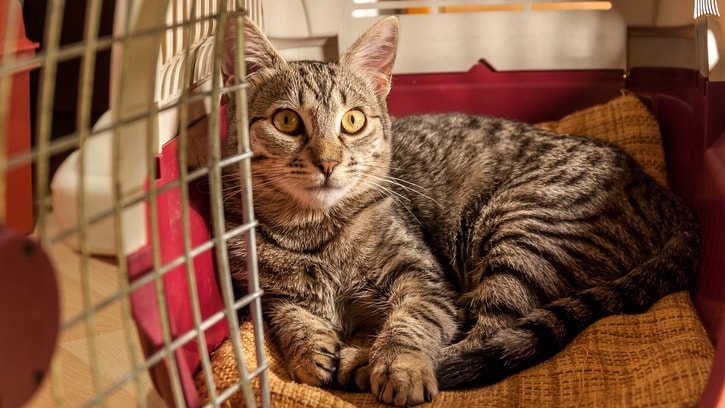What to know
- Many evacuation centers (such as Red Cross evacuation centers) do not allow pets and other animals.
- Make plans that include your pets before an emergency so you can identify shelters that will accept animals or alternatives such as family members, local relief organizations, or rescue groups.
- Keep pets healthy and practice good hygiene in evacuation centers.

Overview
During a disaster, people as well as their pets are often displaced from their homes into evacuation shelters. Evacuation shelters try to provide a safe and healthy environment for anyone who is displaced during a disaster. Although pets can provide comfort during the stress of an emergency, it's important to know the potential health and safety risks of housing animals and people together in an evacuation center.
Potential health risks
Any time animals and people are in close contact, there is a risk for illness and injury. Animals in evacuation centers may be scared or stressed, making them more likely to bite or scratch their owners, other people, or other pets. Crowded conditions make it more likely certain germs will spread between animals and people, and it can be difficult to provide proper sanitation (such as disposal of urine and feces) for pets in evacuation centers. In addition, some people may be allergic to pets with fur or feathers, and allergies can be more serious when people do not have access to their usual allergy medications.
How to stay healthy in an evacuation center
Keep pets healthy
- Owners of dogs, cats, and ferrets should provide proof of vaccination against rabies when entering the shelter.
- Treat dogs and cats for intestinal parasites while at the shelter. This is especially important for pets under 6 months old.
- Treat dogs and cats with medicines to kill fleas and ticks as you normally would while at the shelter. Make sure the medicine used is right for the type of animal being treated.
- If you think your pet might be sick, talk to a veterinarian.
Practice good hygiene
- Wash hands regularly and always after touching pets, pet food, or pet supplies, and after cleaning up their waste. Help children to wash their hands after interacting with any animal.
- Keep pets away from areas where food and drink are prepared, served, consumed, or stored.
- Walk dogs regularly on a leash outside the shelter in designated areas, and always clean up after pets.
- Clean cat litter boxes at least once every 24 hours. Pregnant women should avoid touching or cleaning cat litter boxes, if possible. If no one else can perform the task, pregnant women should wear disposable gloves and wash their hands with soap and water afterwards.
- Do not allow children younger than 5 years old to handle reptiles, amphibians, or poultry.
- Pregnant women should not handle pet rodents such as hamsters, gerbils, rats, and guinea pigs.
- Do not share food with pets.
- Do not allow pets to lick your face.
- Keep pets with fur or feathers separate from people with allergies or asthma triggered by fur, feathers, or dander.
Avoid bites and scratches
- Keep pets caged or on a leash for their own safety as well as that of people and other animals.
- Take care to avoid bites and scratches. If you are bitten or scratched by an animal, clean the wound with soap and water immediately and then talk to a healthcare provider.
- Always supervise young children around animals, even trusted family pets.
Diseases spread between animals and people
Although the risk is usually small, physical stress, crowded conditions, exposure to floodwaters, and contaminated food and water can increase the risk of certain diseases spreading between animals and people in an evacuation center. Just a few examples include:
- Leptospirosis is a bacterial disease found in the urine of infected animals that can cause kidney damage in people and affect other organs. It is spread through contact with infected urine or water, soil, and food that has been contaminated with the urine of infected animals.
- Psittacosis is a bacterial infection that causes pneumonia and can spread through exposure to infected birds. It is often best to also house pet birds, especially parakeets, parrots, love birds, and canaries away from the general shelter population.
- Ringworm is a skin infection caused by fungi that can spread by touching an infected animal or person, or surfaces that they have touched. Ringworm can cause a ring-like rash and itching in both pets and people.
- Salmonella infection is caused by bacteria that live in the intestinal tract of many animals. Reptiles, amphibians, backyard poultry, and small rodents such as guinea pigs commonly shed Salmonella germs in their feces. In people, Salmonella infection can cause diarrhea, vomiting, fever, and abdominal cramps.
- Toxoplasmosis, an infection caused by a parasite sometimes found in cat feces, and lymphocytic choriomeningitis virus (LCMV), a virus that can be spread by some pet rodents, can both cause birth defects if a pregnant woman becomes infected.
- Diseases spread by fleas, ticks, and mosquitoes can spread when animals are in close contact with people. Bites from fleas, ticks, and mosquitoes can irritate the skin and also spread diseases that are harmful to both people and animals.
Bites and scratches
Animal bites and scratches can cause not only pain, injury, and nerve damage, but also infections. Serious bite wounds require medical attention and sometimes surgery. If a bite leads to an infection, the person may need to be treated with antibiotics, a tetanus booster, or receive other medical care.
Dogs, cats, and ferrets can become infected with rabies—a deadly disease that affects the nervous system—and spread it to people or other animals through bites. If you are bitten by a dog, cat, or ferret in an evacuation center, see a doctor immediately to determine if you need a rabies vaccination.
